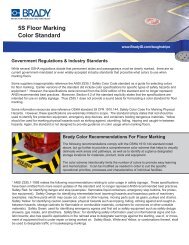INTRODUCTION OBJECTIVES - Plant Services
INTRODUCTION OBJECTIVES - Plant Services
INTRODUCTION OBJECTIVES - Plant Services
- No tags were found...
Create successful ePaper yourself
Turn your PDF publications into a flip-book with our unique Google optimized e-Paper software.
Chapter 4 — Hydraulic Pumps 121Figure 4-20. Vane pump manufacturers typically provide assembly diagrams for each specific pump.For example, a cam ring in a vane pumpis replaced by applying the followingprocedure:1. Remove the pump from its foot bracketby removing the bolts.2. Remove four bolts from the back of thepump.3. Disassemble the pump into three sections.a. One section is the back housing withO-rings.b. Another section is the cartridge assembly.c. The third section is the front housingwith the shaft.4. Place all parts in a straight line in the exactorder that they were disassembled.5. Inspect all the seals that connect thethree main sections together.a. If the seals are good, go to step 6.b. If the seals are worn or damaged,replace them.6. Inspect the ball bearings for wear andlubrication. Replace or regrease asrequired.7. Remove two screws holding the vanecartridge together.8. Place all parts from the vane cartridgein a straight line in the exact order thatthey were disassembled.9. Remove the cam ring and the rotor,making sure that the vanes do not fallout of the rotor.10. Remove all vanes from the rotor andinspect for premature wear.11. Replace the damaged cam ring with anew cam ring.12. Reassemble the vane pump by workingbackwards from step 11.Piston PumpsA piston pump is a hydraulic pump in whichfluid flow is produced by reciprocatingpistons. Piston pumps are either fixed orvariable displacement. They use a rotatinginternal piston assembly to create a vacuumas the pistons pull away from the inlet. Thepiston assembly then forces fluid out whenthe pistons are pushed toward the outlet.A bent-axis piston pump is the mostdurable type of hydraulic pump and canoperate at pressures of up to 10,000 psi.Piston pumps are typically used in applicationssuch as small loaders. Types of pistonpumps include axial, variable-displacement,bent-axis, and radial piston pumps.TECH FACTTo achieve a uniform volumetric flowrate of hydraulic fluid, hydraulic pistonmachines, such as piston pumps, aredesigned with an odd number of pistons.For example, many hydraulic pistonpumps are designed to house seven ornine pistons.












